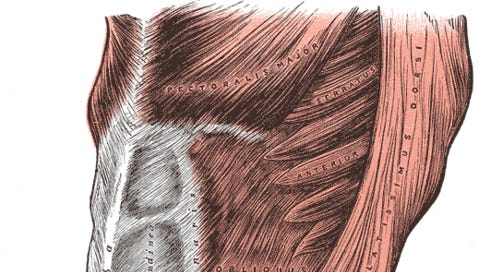This week I want to spend some time looking at the concept of the core - particularly as it relates to posture. The idea of the core is commonplace in the sphere of exercise, coaching and physical activity. If you search ‘core workout’ on Youtube you are instantaneously met with a hundred thumbnails of glossy looking people with rippling bodies - each of which makes me think I should probably spend more time exercising my core.
However, it’s important to note that the idea of the core is exactly that - an idea. It’s not a fixed structure in the abdomen. Anatomists will argue about what muscles make up the core - raising questions about how many of the peripheral structures in the abdomen, pelvic floor, shoulders or hips should be included. There are also questions about when certain muscles should be included. Activation of the core is always functional. Different activities demand different uses of the self. Holding the spine in a neutral position in standing is not the same as holding the spine in neutral in a press-up or a headstand. Both activities might involve the same muscles, but they are being recruited and activated in very different ways.
This is why we should be skeptical of the idea that spending time improving the length of our plank hold might improve our posture or our ability to perform a handstand. If doing a handstand required a bulging six-pack or big pectoral muscles, children wouldn't be able to do them. If good posture was fundamentally reliant on the strength of the rectus abdominus, postpartum women wouldn’t be able to stand up and walk.
A lot of the conventional practice around core training is about holding (isometric contraction). I’ve seen lots of coaches talk about core stability. Whenever I hear this I’m reminded of the following quote from Moshe Feldenkrais:
"The human nervous system is 90 percent concerned with recovery of stability, but life is not a stable process. Stability is for trees. For us, life is a process of risk and recovery. Each step we take is a risk. The ability to recover is our greatest quality. Stability? You have stability when you go to bed. And you keep risking, because one experience is not enough. If it were, then one glass of wine would be sufficient. One game won. One success."
With this is mind, I think it’s worth prioritising core mobility over core stability.
Posture is not the capacity to hold onto your muscles, prevent them from moving and keep still. It’s about the process of recovering balance. To do this successfully, we need to attend to the ways in which the core might be understood not as a fixed unit, but as an orchestra in which the individual players work together in unison while maintaining their own agency and identity. We need to become aware of the role each of our muscles plays as we change our position in space and our relationship to gravity. The core we use in a headstand is different from the core we use in a pull up. Not because we are using different muscles, but because we are drawing on different images of those muscles in our motor cortex.
The biggest take away here is not that the core is an idea rather than an anatomical reality. Instead, it’s that the core is an infinite number of ideas, jostling for space in our self-image as we negotiate the world.
This week’s lesson is a little different. I haven’t recorded an audio file. Instead, I want to share one of my favourite warm ups. It’s an opportunity to attend to the process of recovering balance, engaging in what the dancer Steve Paxton called ‘the small dance’. It’s also an activity that the French choreographer Dominique Dupuy used a lot in his training.
It’s very simple:
Find a space where you feel safe and aren’t worried about bumping into to something or falling.
Set a timer for 5 minutes.
Close your eyes.
Stand.
Don’t hold yourself still. Allow yourself to attend to the ways in which the muscles in your spine, diaphragm and hips make tiny adjustments to the process of standing. Notice the movements in your knees and ankles. Keep your breathing steady and easy. Remember that stability is for the trees.




What a lovely idea and really well explained. Thank you!